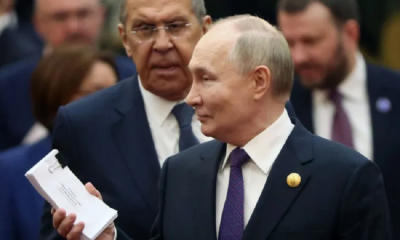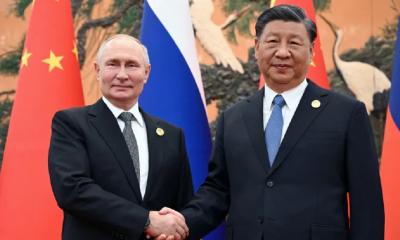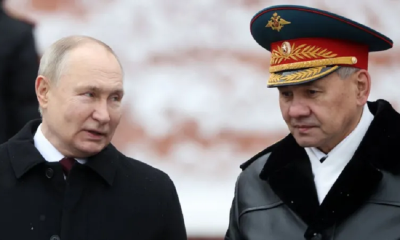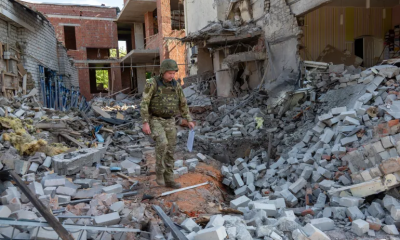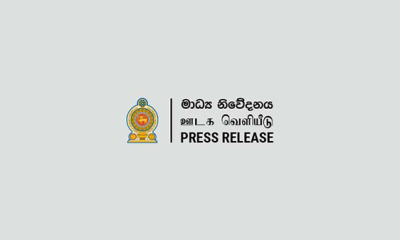Foreign News
Little chance of change as Vladimir Putin is sworn in again

For the fifth time Vladimir Putin will be taking the long walk through the Grand Kremlin Palace to the St Andrew’s Throne Hall. There he will take the oath of office and be sworn in as Russia’s president for a new six-year term
The route may be familiar, but much has changed since Putin’s first inauguration ceremony in May 2000. Back then, President Putin pledged to “preserve and develop democracy” and to “take care of Russia.”
Twenty-four years on, the Kremlin leader is waging war against Ukraine; a war in which Russia has suffered heavy losses. At home, instead of developing democracy, President Putin has been curtailing it: jailing critics, removing all checks and balances on his power.
“Putin thinks of himself now as Vladimir the Great, as a Russian tsar,” believes Fiona Hill, a former White House national security advisor. “If we took ourselves back to his first two presidential terms, I think we’d have a fairly favourable assessment of Putin. He stabilised the country politically and made it solvent again. The Russian economy and system were performing better than at any other previous time in its history. “The war in Ukraine, going back to the annexation of Crimea 10 years ago, has dramatically changed that trajectory. He’s turned himself into an imperialist instead of a pragmatist.”
It’s remarkable to think that since Vladimir Putin first came to power, America has been through five different presidents and Britain has had seven prime ministers.
After nearly a quarter of a century running Russia, Mr Putin has certainly made his mark. In the past, people rarely spoke of “Brezhnevism”, “Gorbachevisim” or “Yeltsinism”. But Putinism: that’s a thing.
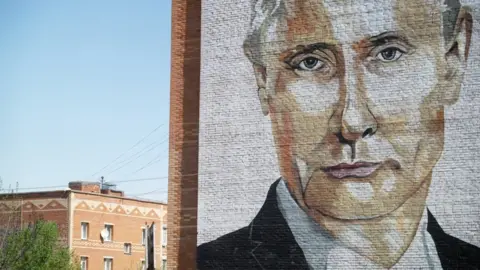
Most people have grown used to one man running Russia and no imminent prospect of change in the Kremlin (BBC)
“We have one more -ism in our history: Stalinism,” says Andrei Kolesnikov, senior fellow at the Carnegie Eurasia Russia Centre.
“I would say that Putinism is one more incarnation of Stalinism. He behaves like [former Soviet dictator] Stalin. His power is personalised like in Stalin’s time. He prefers to use a lot of political repressions. And like Stalin he is ready to keep himself in power until the physical end.”
The challenge, for the West, is how to deal with an increasingly authoritarian Russian leader determined to restore what he sees as Russia’s greatness; a modern-day tsar… with nuclear weapons.
“On the issue of nuclear weapons, there’s an awful lot that we can do,” believes Fiona Hill. “Some countries, like China, India, Japan, have been extraordinarily nervous when Putin has engaged in nuclear sabre-rattling in Ukraine and have pushed back against that. We can enforce restraint on Russia by creating an international framework for pushing back on this wild and speculative talk about using nuclear weapons.
“Perhaps that is something of a model for how we can deal with Vladimir Putin, who in many respects is something of a rogue leader. We need to create a more constraining environment, less permissive for the kinds of actions that he wants to undertake.”
Officially Vladimir Putin won more than 87% of the vote in the March presidential election. However, he’d faced no serious challenger in a contest widely seen as neither free not fair.
So how do Russians view the longest-serving Kremlin leader since Joseph Stalin?

“We don’t know who would come next if Putin goes,” says Valentina
To find out I drive to the town of Kashira, 70 miles from Moscow. Here a gigantic Putin portrait, a massive mural, takes up one whole side of an apartment block.
In Kashira Big Vladimir is watching you. “I like him,” says pensioner Valentina who is selling flowers by the roadside. “Putin has good ideas and does a lot for people. True, our pensions aren’t big. But he can’t fix everything in one go.”
“He’s had nearly 25 years,” I point out.
“But we don’t know who’d come next [if Putin goes],” Valentina replies.
“In Russia we’re all expected to think the same way,” says Victoria, who is walking past the Putin mural. “If I say anything against Putin my husband says: ‘You criticise Putin again and I’ll divorce you!’ He’s mad about him. He says that if it wasn’t for Putin life here would be as tough as in the 1990s.”
When I ask another passer-by, Alexander, what he thinks of the president, he replies: “It can be dangerous now to express an opinion. No comment.”
Most of the people I talk to say that they walk past Putin’s portrait without even noticing it now. They’re used to it.
Just like they’ve grown used to one man running Russia and no imminent prospect of change in the Kremlin.
(BBC)
Foreign News
Nasa ‘Earthrise’ astronaut dies at 90 in plane crash

Apollo 8 astronaut Bill Anders, who snapped one of the most famous photographs taken in outer space, has died at the age of 90.
Officials say a small plane he was flying crashed into the water north of Seattle, Washington.
Anders’ son Greg confirmed that his father was flying the small plane, and that his body was recovered on Friday afternoon. “The family is devastated. He was a great pilot. He will be missed,” a statement from the family reads.
Anders – who was a lunar module pilot on the Apollo 8 mission – took the iconic Earthrise photograph, one of the most memorable and inspirational images of Earth from space.
Taken on Christmas Eve during the 1968 mission, the first crewed space flight to leave Earth and reach the Moon, the picture shows the planet rising above the horizon from the barren lunar surface.
Anders later described it as his most significant contribution to the space programme.

The image is widely credited with motivating the global environmental movement and leading to the creation of Earth Day, an annual event to promote activism and awareness of caring for the planet.
Speaking of the moment, Anders said: “We came all this way to explore the Moon, and the most important thing that we discovered was the Earth.”
Officials said on Friday that Anders crashed his plane around 11:40PDT (1940BST).
The US National Transportation Safety Board (NTSB) said the 90-year-old was flying a Beechcraft A A 45 – also known as a T-34. The agency said that the plane crashed about 80ft (25m) from the coast of Jones Island.
Anders also served as the backup pilot to the Apollo 11 mission, the name of the effort that led to the first Moon landing on July 24, 1969.
Following Anders’ retirement from the space programme in 1969, the former astronaut largely worked in the aerospace industry for several decades. He also served as US Ambassador to Norway for a year in the 1970s.
But he is best remembered for the Apollo 8 mission and the iconic photograph he took from space.
“In 1968, during Apollo 8, Bill Anders offered to humanity among the deepest of gifts an astronaut can give. He traveled to the threshold of the Moon and helped all of us see something else: ourselves,” Nasa Administrator Bill Nelson said in a statement.
Mark Kelly, a former astronaut who now serves as a US Senator for the state of Arizona, said in a post on X, formerly Twitter, that Anders “inspired me and generations of astronauts and explorers. My thoughts are with his family and friends”.
[BBC]
Foreign News
China’s Chang’e-6 lifts off from far side of Moon with rock samples

A Chinese spacecraft carrying rock and soil samples from the far side of the Moon has lifted off from the lunar surface to start its journey back to Earth, according to state media.
The achievement on Tuesday is a world first and the latest leap for Beijing’s decades-old space programme, which aims to send a crewed mission to the Moon by 2030.
The Xinhua News Agency, citing the China National Space Administration (CNSA), said that the ascender of the Chang’e-6 probe took off at 7:38am local time on Tuesday (23:38 GMT) and entered a preset orbit around the moon.
It described the move as “an unprecedented feat in human lunar exploration history”.
The Chang’e-6 probe was launched last month and its lander touched down on the far side of the Moon on Sunday. It used a drill and robotic arm to dig up soil on and below the Moon’s surface, according to Xinhua.
After successfully gathering its samples, the Chang’e-6 unfurled China’s national flag for the first time on the far side of the Moon, it said.
The agency cited the CNSA as saying that the spacecraft stowed the samples it had gathered in a container inside the ascender of the probe as planned.
[Aljazeera]
Foreign News
China says its spacecraft lands on Moon’s far side

China says its uncrewed craft has successfully landed on the far side of the Moon – an unexplored place almost no-one tries to go.
The Chang’e 6 touched down in the South Pole-Aitken Basin at 06:23 Beijing time on Sunday morning (22:23 GMT Saturday), the China National Space Administration (CNSA) said.
Launched on 3 May, the mission aims to collect precious rock and soil from this region for the first time in history. The probe could extract some of the Moon’s oldest rocks from a huge crater on its South Pole.
The landing was fraught with risks, because it is very difficult to communicate with spacecraft once they reach the far side of the Moon. China is the only country to have achieved the feat before, landing its Chang’e-4 in 2019.
After launching from Wenchang Space Launch Center, the Chang’e 6 spacecraft had been orbiting the Moon waiting to land. The lander component of the mission then separated from the orbiter to touch down on the side of the Moon that faces permanently away from Earth.
During the descent, an autonomous visual obstacle avoidance system was used to automatically detect obstacles, with a visible light camera selecting a comparatively safe landing area based on the brightness and darkness of the lunar surface, the CNSA was quoted as saying by state-run Xinhua news agency.
The lander hovered about 100m (328ft) above the safe landing area, and used a laser 3D scanner before a slow vertical descent. The operation was supported by the Queqiao-2 relay satellite, the CNSA said.
Chinese state media described the successful landing as an “historic moment”. The state broadcaster said “applause erupted at the Beijing Aerospace Flight Control Center” when the Chang’e landing craft touched down on the Moon early on Sunday morning.
The lander should spend up to three days gathering materials from the surface in an operation the CNSA said would involve “many engineering innovations, high risks and great difficulty”. “Everyone is very excited that we might get a look at these rocks no-one has ever seen before,” explains Professor John Pernet-Fisher, who specialises in lunar geology at the University of Manchester.
He has analysed other lunar rock brought back on the American Apollo mission and previous Chinese missions. But he says the chance to analyse rock from a completely different area of the Moon could answer fundamental questions about how planets form.
Most of the rocks collected so far are volcanic, similar to what we might find in Iceland or Hawaii. But the material on the far side would have a different chemistry . “It would help us answer those really big questions, like how are planets formed, why do crusts form, what is the origin of water in the solar system?” the professor says.
The mission aims to collect about 2kg (4.4lb) of material using a drill and mechanical arm, according to the CNSA.
The South Pole–Aitken basin, an impact crater, is one of the largest known in the solar system.
From there, the probe could gather material that came from deep inside the lunar mantle – the inner core of the Moon – Prof Pernet-Fisher says.
The Moon’s South Pole is the next frontier in lunar missions – countries are keen to understand the region because there is a good chance it has ice.

The capsule in the last Chinese moon mission, Chang’e 5, brought back soil and rocks in 2020 (BBC)
Access to water would significantly boost the chances of successfully establishing a human base on the Moon for scientific research.
If the mission succeeds, the craft will return to Earth with the precious samples on board a special return capsule.
The material will be kept in special conditions to try to keep it as pristine as possible.
Scientists in China will be given the first chance to analyse the rocks, and later researchers around the world will be able to apply for the opportunity too.
This is the second time China has launched a mission to collect samples from the Moon.
In 2020 Chang’e 5 brought back 1.7kg of material from an area called Oceanus Procellarum on the Moon’s near side.
China is planning three more uncrewed missions this decade as it looks for water on the Moon and investigates setting up a permanent base there.
Beijing’s broader strategy aims to see a Chinese astronaut walk on the moon by around 2030.
The US also aims to put astronauts back on the moon, with Nasa aiming to launch its Artemis 3 mission in 2026.
(BBC)


